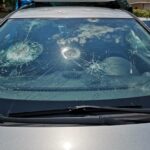A half mile below the Chihuahuan Desert, the air is still and quiet in the dark passages of the Waste Isolation Pilot Plant.
Around 25 employees worked Friday in the underground to improve safety at the New Mexico site and maintain its constantly shifting salt walls, floors and ceilings. Two years ago, 120 employees were doing the same work.
The Current-Argus got a glimpse of the underground as the Department of Energy and the Nuclear Waste Partnership led the first media tour into the mine since the 2014 fire and radiological incident shut down underground operations.
The tour was guided by Mark Pearcy, deputy operations manager for the underground for the Nuclear Waste Partnership.
After a 5-minute, 2,150-foot descent in the waste hoist, safety signs are immediately visible, along with TV screens displaying messages to workers in the underground. In another area, one reads, “Accidents never just happen – They are caused!”
The air underground is stuffy and stagnant because airflow in the mine has been much lower since the release incident in 2014. The supplemental and interim ventilation systems are not yet online.
Workers were seldom seen in the 12 miles of tunnels throughout the mine, something that Pearcy said is much different compared to before the 2014 incidents.
Of the workers in the underground on Friday, some were inserting bolts into walls and ceilings to stabilize the salt that is continually closing in.
Other employees focused on operating salt and waste hoists. Some guarded contaminated areas, like Panel 7, which is where the radiological release occurred in 2014.
Lockers are spaced out sporadically throughout the tunnels. Some contain workers’ valuables while others have self-contained self-rescuers.
There are 400 self-contained self-rescuers spread around for just under 100 employees to use in case of an emergency.
Before going underground, Pearcy demonstrated the use of a self-contained self-rescuer in case of lack of oxygen or in case of the presence of carbon monoxide, something workers and visitors must also now demonstrate. Many workers had trouble putting them on when a salt truck caught fire underground in February 2014.
“I don’t want the first time for you to operate one of these, if it’s in the heat of the moment, to be completely flustered and not recognize the simplicity of this,” Pearcy said.
Before the fire, workers were verbally trained on how to use the devices, but never actually got hands-on experience with them.
Pearcy said now, all workers are tested annually on how to use them. He said they are also randomly tested on their use as well.
Another added safety precaution are color-coded reflectors attached to the walls, or “ribs” of the mine. Green indicates the quickest way to a hoist, red indicates an alternate route and white indicates that you are moving away from an exit.
Pearcy said the reflectors have always been in place, but they have been installed at different heights since the fire so that those crawling on the ground to avoid smoke can also see the markers.
As part of their decontamination efforts, workers covered the floors with sheets of yellow plastic near the end of last year. The edges of the plastic can be seen at the base of the salt walls.
The plastic, known as brattice cloth, serves to block any radioactive material that may have settled on the floor. That material was then covered with salt.
Pearcy said the yellow material will serve as a warning to workers, should the salt floor be worn away and it becomes visible underfoot. It will then be re-covered with more salt.
The stretch of drift (access tunnel) where the brattice cloth is installed is known to workers as the “Yellow Brick Road,” Pearcy said.
Todd Shrader, manager of the Carlsbad Field Office of the Department of Energy, said cold operations should begin in the next six weeks.
Cold operations will last eight weeks and will provide training and drills for workers before waste emplacement begins again in December 2016.
Then, WIPP officials hope, the quiet tunnels of the underground will again bustle with activity as radioactive waste is transported to its final resting place.
Was this article valuable?
Here are more articles you may enjoy.

 CoreLogic Report Probes Evolving Severe Convective Storm Risk Landscape
CoreLogic Report Probes Evolving Severe Convective Storm Risk Landscape  Jury Awards $80M to 3 Former Zurich NA Employees for Wrongful Termination
Jury Awards $80M to 3 Former Zurich NA Employees for Wrongful Termination  South Carolina Allows Out-of-State Adjusters After Massive Hail Storm
South Carolina Allows Out-of-State Adjusters After Massive Hail Storm  Viewpoint: The Impact of Behavioral Health on Workers’ Comp
Viewpoint: The Impact of Behavioral Health on Workers’ Comp 